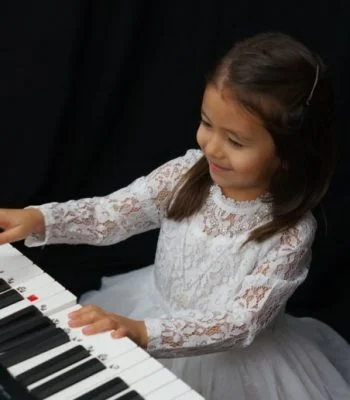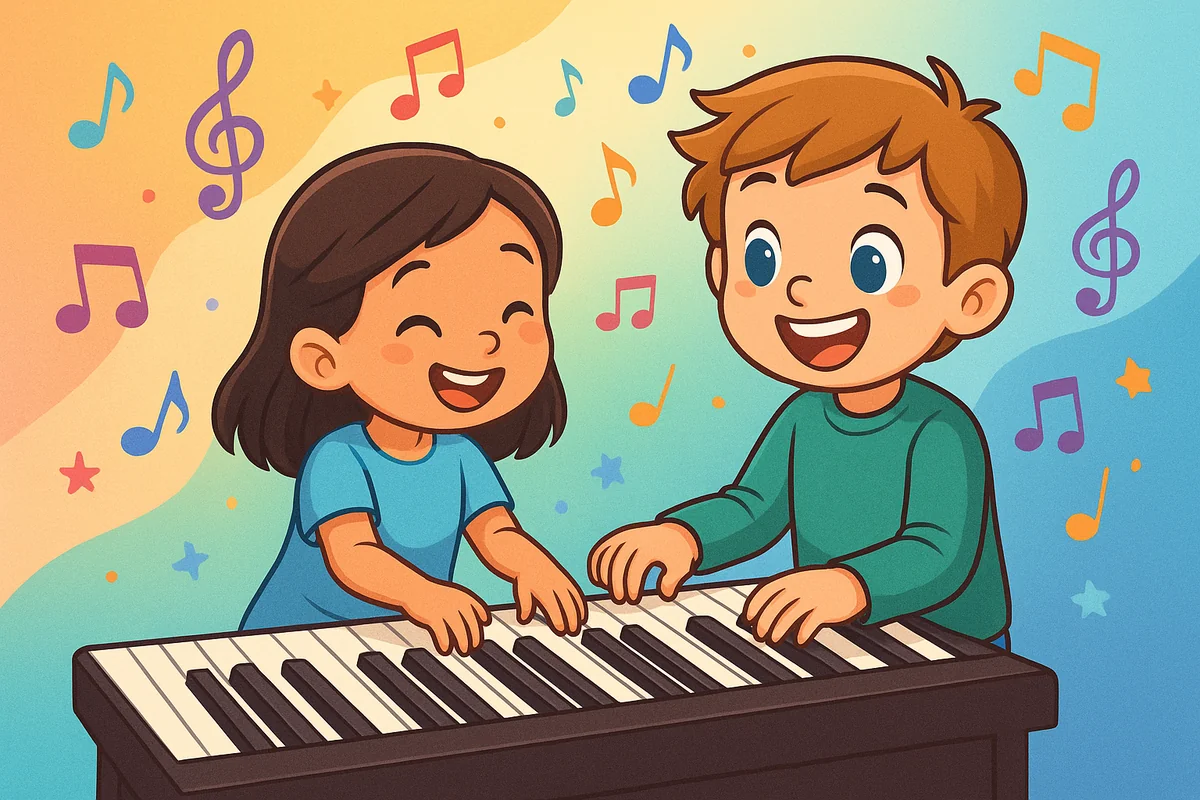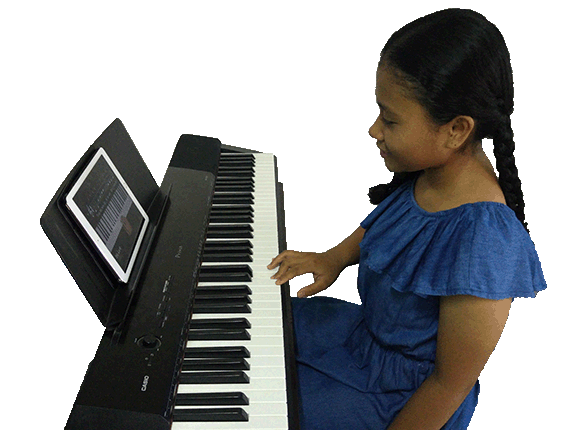If you’ve been looking for piano lessons for kids that are fun, simple, and easy to follow, you’re in the right place. Learning the piano should never feel like a chore, especially for young students who are just discovering music for the first time. That’s why our step-by-step program was designed with children in mind: short lessons, colorful visuals, easy-to-remember songs, and playful teaching methods that help kids stay motivated.
This program includes 15 carefully structured lessons, each one building on the last so kids can see progress quickly. Along the way, they’ll learn 10 memorable songs that start with familiar nursery rhymes and move into popular classics that both children and parents will love. By the time students finish these lessons, they won’t just be pressing keys — they’ll be making music.

These songs aren’t random — they were selected to teach specific skills. For example, “Mary Had a Little Lamb” helps children understand stepwise motion, while “We Will Rock You” introduces rhythm patterns that keep practice fun and interactive. By playing songs they already recognize, kids feel a sense of achievement early, which is one of the best motivators for sticking with piano. For parents comparing beginner piano lessons for kids, this structure makes progress clear from lesson one.

Parents often ask what makes these piano lessons for kids different from other online courses. The answer is in the teaching style. Every lesson uses a playful but structured approach, guiding children through hand positions, fingering, rhythm, and music reading at their own pace. Visual aids — like showing how to hold a ball for proper hand shape — make abstract concepts easy to understand. If you’re seeking online piano lessons for kids, this same approach works at home on any keyboard or piano.
Instead of overwhelming young learners with theory, we balance just enough instruction with plenty of playing. Each new technique is immediately applied in a song, so children feel the connection between what they’ve learned and the music they create. To learn more about the wider benefits of music education , research consistently highlights gains in focus, coordination, and confidence. By the end of the 15 lessons, kids will be confident enough to sit down at the piano and share music with their family and friends.
In short, these piano lessons for kids give your child the tools to succeed: a proven structure, 10 fun songs, and clear, easy-to-follow guidance. The journey starts here, and it’s one your child will enjoy from the very first note.
One of the most exciting parts of starting piano lessons for kids is giving them a sense of accomplishment right away. Instead of beginning with long scales or difficult exercises, children in this course jump directly into playing real songs they already know and love. These “first wins” make all the difference, because when a child recognizes a tune they’ve just played on the keyboard, their eyes light up with pride — and their motivation to keep learning grows.
In the early lessons, we focus on songs that are short, repetitive, and built on easy patterns. These pieces are perfect because they use a limited set of notes, yet they teach essential skills like rhythm, finger movement, and hand coordination. Families choosing beginner piano lessons for kids — or exploring online piano lessons for kids at home — will see quick progress without frustration.
Stepwise melodies for finger control
Simple rhythmic patterns for steady timing
Hand coordination and confidence from day one

Each of these songs connects directly to a learning goal. For instance, “Mary Had a Little Lamb” helps children see how melodies move up and down by step, while “Twinkle, Twinkle, Little Star” begins to introduce skips and wider intervals. By playing familiar tunes, kids build foundational skills without even realizing they’re practicing technique.
Mary Had a Little Lamb – A simple melody using stepwise notes, perfect for teaching finger control.
Twinkle, Twinkle, Little Star – Teaches repeating patterns and introduces jumps between notes.
Jingle Bells – Helps students learn rhythm while keeping practice joyful and festive.
We Will Rock You – A fun, rhythmic piece that turns piano practice into a clapping and stomping game.
The Hand Song – A short exercise disguised as a song that reinforces finger numbers and positions.
Children learn fastest when the music feels familiar. Because these songs are already part of their everyday world — whether sung at school, during holidays, or at birthday parties — kids instantly recognize the melodies. That recognition keeps them focused, encourages repetition, and makes each small success feel bigger.
Another benefit of familiar songs is that parents can sing along. When Mom, Dad, or siblings join in with the lyrics while the child plays, practice time turns into family time. This positive reinforcement helps young students feel supported, which is one of the strongest motivators to keep learning.
These early pieces are not the end of the journey, but rather stepping stones. Once kids can comfortably play songs like “Jingle Bells” and “We Will Rock You,” they are ready to move into slightly more challenging pieces such as “Ode to Joy” and “Lean on Me,” which appear later in the program. By starting simple and gradually increasing the difficulty, children learn without frustration — and every success makes them eager for the next.
With these simple yet powerful first wins, your child will begin to feel like a real musician right away. The joy of making music will inspire them to keep returning to the piano day after day, laying the foundation for a lifetime of musical growth.

Give your child a joyful start in music! Our kid-friendly lessons make learning piano, guitar, and ukulele fun and engaging — plus singing, music theory, and creative activities like chess & drawing.
Parents are often surprised to learn that piano lessons for kids can begin as early as age three or four. While it may sound young, children at this stage are already developing fine motor skills, rhythm awareness, and the ability to recognize patterns — all of which translate beautifully into early music education. In fact, preschool piano lessons work best when taught with playfulness and structure, making learning both enjoyable and effective.
At this age, lessons are short and simple. Instead of focusing on long practice sessions, we concentrate on hands-on activities that capture a child’s curiosity. For example, one favorite preschool teaching tool is the “ball method.” By holding a small ball in their hand, children learn to maintain the natural curved shape required for good piano technique. This playful approach helps them establish proper posture without the stress of complicated instruction — ideal for piano lessons for preschoolers.
Simple exercises help preschoolers gain control of small muscles.
Early exposure to rhythm and melody develops keen ears for sound patterns.
Repetitive songs strengthen concentration and recall.
Each completed song, no matter how simple, builds pride and momentum.
Preschool children also benefit emotionally from learning music. Playing familiar tunes like Mary Had a Little Lamb or Jingle Bells gives them the joy of recognition, while fun rhythmic songs like We Will Rock You invite movement and clapping. This combination of sound and motion keeps lessons lively and avoids frustration — a win for families using beginner piano lessons for kids at home.
Not every song suits a three- or four-year-old beginner, which is why we include a hand-picked selection in our 15-lesson program. These choices focus on repetition, easy note patterns, and steady rhythm. Here are a few favorites preschoolers can learn quickly
Teaches finger numbers in a fun, memorable way.
Stepwise notes keep the melody easy and familiar.
Encourages singing along while playing.
These pieces are intentionally structured to teach coordination, listening, and musical expression without overwhelming young learners. Every success — even finding the right keys with the right fingers — builds a solid foundation for future lessons. Families who prefer online piano lessons for kids can follow the same sequence on any keyboard or piano at home.
With the right guidance, preschoolers can develop a lifelong love of music. Starting piano young builds coordination, creativity, and confidence — and lays the groundwork for more advanced songs as they grow.
Keep sessions short (5–10 minutes) and frequent.
Use stickers or colorful note cards to mark key positions.
Encourage exploration and singing — make it feel like playtime.
Celebrate tiny wins to keep motivation high.
One of the best ways to inspire young students is to let them see and hear what they can achieve. That’s why our piano lessons for kids include short video previews, giving children a chance to follow along and experience success right away. Our 30-second clip of Old MacDonald Had a Farm is a perfect example. With on-screen notes, finger numbers, and a clear view of the keyboard, kids can begin playing a favorite melody in no time—great for families exploring beginner piano lessons for kids or online piano lessons for kids at home.
Children love Old MacDonald because it’s cheerful, repetitive, and easy to sing along with. Parents love it because it builds rhythm, hand coordination, and musical memory. Even preschoolers can tap the beat, while older beginners can play the melody confidently after a little practice.

Instant engagement — kids recognize the tune and want to try it immediately.
Clear visual guidance — on-screen notes and finger numbers reduce confusion.
Self-paced — pause/rewind enables bite-size practice.
Parent involvement — watch together and guide simple repetitions.
Unlike traditional lessons that can feel overwhelming at the start, short previews provide an achievable goal in minutes, keeping motivation high and frustration low.
While playful, the clip reinforces several first-lesson essentials:
Finger numbers matched to on-screen prompts
Right/left hand coordination on a simple pattern
Steady beat through repeated phrases
Short-term memory via the “E-I-E-I-O” motif
Because the video is brief, kids watch, try, and succeed—often in the first session. This confidence sets up later wins with pieces like Ode to Joy and Happy Birthday.
Sit with your child on the first playthrough, encourage slow practice, and celebrate small steps. A few accurate notes beat many rushed ones. Repetition is the secret to steady progress.
“Place your right hand on the keys. Finger 1 on middle C. Watch the finger numbers on the screen: 3-2-1—good! Keep a steady beat. Now the ‘E-I-E-I-O’ part—repeat that pattern. Nice and slow. Great job—let’s play it once more together!”
A big part of the excitement in our piano lessons for kids comes from the carefully chosen songs inside the printable booklet. These aren’t random tunes—there are 16 hand-picked pieces designed to build skills step by step while keeping kids motivated with familiar, fun melodies. Across 15 lessons, each new concept is reinforced with a song your child will be proud to play.
The printable piano booklet is included with the course and can be printed at home or viewed on any device. Keep it on the piano stand for quick reference and let kids highlight songs they’ve mastered—an easy, motivating way to see real progress. For families just starting out, this layout also supports beginner piano lessons for kids with simple, trackable milestones.

The Hand Song – Learn finger numbers and strengthen muscle memory.
Mary Had a Little Lamb – Stepwise melody for early control.
Twinkle, Twinkle, Little Star – Repeating patterns and simple intervals.
Jingle Bells – Joyful rhythm practice with a familiar tune.
We Will Rock You – Percussive rhythm; clap/stomp patterns on the keys.
Old MacDonald Had a Farm – Sing-along classic (pairs with the video preview).
Happy Birthday – A must-know tune kids love to share.
Ode to Joy – Introduces classical phrasing and expression.
Lean on Me – Simple chord/melody coordination and teamwork playing.
Hallelujah – Sustained tones and expressive touch.
Preschool Rhythm Pieces – Short, playful exercises for ages 3–4.
Finger Warm-Up Tunes – Gentle patterns that build coordination.
Practice Progressions – Step and skip patterns for both hands.
Melody & Harmony Duets – Sibling or parent-child duet options.
Review Songs – Fun variations that reinforce earlier lessons.
Final Celebration Song – A capstone piece combining the core skills learned.
Each piece teaches a specific skill: Mary Had a Little Lamb trains stepwise motion, while Ode to Joy builds phrasing and musicality. Blending nursery rhymes, holiday music, pop rhythms, and classical melodies keeps practice fresh and engaging while developing core technique. It’s an easy way to introduce beginner piano songs for kids without overwhelming new learners.
Treat the booklet like a roadmap. Check off songs as your child masters them, and use the notes at the bottom of each page to track tempo goals or fingerings. By the end of the 15 lessons, your child will confidently play 16 songs and be ready for the next level.
When it comes to piano lessons for kids, the way children place their hands on the keys is one of the most important foundations they will ever learn. Good technique not only makes playing easier in the moment, but also prevents bad habits that could slow progress later on. That’s why our course introduces proper hand position and finger numbering from the very beginning, using fun and memorable methods kids can actually understand.
These online piano lessons for kids even work for preschool children. Kids will also learn correct fingering. Each song they learned has a unique fingering to make it easier for them to learn. Along with correct fingering, they will also learn the correct hand position using a ball. These videos are also designed for preschool piano lessons for 3 & 4 years old.
To keep things simple, we use what we call the “ball method.” Children imagine holding a small ball, like a tennis ball, in the palm of their hand. This naturally curves the fingers, creates space under the hand, and encourages relaxed wrists. When kids place this same hand shape over the keys, they automatically fall into the correct position without stress or stiffness.
Parents love this approach because it’s easy to demonstrate at home. Just hand your child a small ball and watch their hand naturally form the correct playing shape. Once they place that hand on the keys, they’re already halfway to a great piano technique.
Alongside proper hand shape, children need to know which finger to use on which key. That’s where fingering numbers come in. In our piano lessons for kids, every finger is assigned a number:
This simple numbering system allows children to follow along with songs easily. When they see a “3” written above a note, they know it’s their middle finger. When they see a “5,” they know to use their pinky. This eliminates guesswork and helps kids build confidence quickly as they match notes to the correct fingers.
Many young beginners try to play everything with just one or two fingers, which might work for short melodies but quickly becomes limiting. By teaching fingering patterns early, children learn how to move smoothly up and down the keyboard. They also develop stronger coordination between both hands, which prepares them for more complex music later on.
Good fingering habits also help with speed and accuracy. Instead of struggling to reach notes, children discover that the “right finger on the right key” makes songs feel easier and more natural to play.
We don’t just drill fingering like a math exercise — we turn it into games. Children sing “finger songs,” clap rhythms with different finger numbers, and even trace their hands on paper to practice naming each finger. These interactive activities make technique fun while reinforcing the basics.
Once kids are comfortable with hand position and finger numbers, they are ready to tackle longer songs like Ode to Joy, Lean on Me, and Happy Birthday. These pieces require smooth transitions across the keyboard, which would be frustrating without good fingering habits. Because we establish the fundamentals early, students can enjoy these songs without struggling or giving up.
With curved hands, relaxed wrists, and clear finger numbers, your child will feel confident from the first lesson. These building blocks form the core of every great pianist’s technique — and now your child can master them too, one fun step at a time.
Modern parents have busy schedules, and kids often juggle school, sports, and activities. That’s why piano lessons for kids at JamGuitar are designed to fit your lifestyle. Instead of rushing to and from appointments, children can learn right from home with structured video lessons and a printable booklet that guides their progress. This flexibility is one of the biggest reasons more and more families are choosing online learning.
For many families, traditional in-person lessons can feel overwhelming. Between transportation, scheduling, and costs, it’s easy for kids to miss practice or lose momentum. Online lessons remove those barriers. Whether your child wants to practice before school, after dinner, or on weekends, the materials are always ready and waiting.

These video lessons are designed just for kids. They are very easy to learn starting with the most elementary concepts of music. Kids will first learn what is pitch and how that is control on the piano. Plus, they will learn the basics of rhythm with basic counting techniques. After that the kids will dive into learning the names of musical notes. Then last and most enjoyable part which is learning songs. All the songs have printable piano lessons for kids that are pdf format.
Flexibility – Lessons are available anytime, so kids can learn at their own pace.
Affordability – One low membership fee replaces costly weekly lessons.
Replay Value – Children can watch lessons again and again until concepts stick.Melody & Harmony Duets – Sibling or parent-child duet options.
Comfort of Home – Kids learn in a familiar environment, free from pressure.
Family-Friendly – Parents can sit in, follow along, and support their child’s progress.
Kids stay motivated because they can see their progress instantly. Each new lesson introduces a song, and by the end of 15 lessons, they can play 16 different pieces. Parents don’t have to worry about whether their child is “keeping up” with a teacher’s schedule — the program is self-paced, so no one feels left behind.
Learn anywhere, anytime
Affordable monthly membership
Replay lessons as needed
Flexible pace
Includes video, booklet, and songs
Fixed schedules & travel time
High cost per lesson
Missed concepts if absent
Pressure to keep up with teacher pace
Limited song variety
Parents especially appreciate the savings. Instead of paying $30–$50 per weekly private lesson, JamGuitar offers unlimited monthly access for a fraction of the cost. That means children can practice more often without adding financial stress to the family budget.
Online learning also develops independence. Because kids can pause, rewind, and repeat lessons on their own, they build problem-solving skills that transfer beyond music. They learn responsibility, self-motivation, and persistence — life lessons that last long after the piano keys are silent.
With JamGuitar’s online program, every child has the opportunity to succeed. The combination of video demonstrations, step-by-step lessons, and a colorful booklet ensures they’re never lost or confused. Parents have peace of mind knowing their child is learning in a safe, supportive environment — and children feel the joy of making music every single day.
Each song is played twice. First with the metronome (beats) in the background and second with singing (if the song has lyrics.) The metronome has a human voice to make it much easier for kids to follow. Please check out the sample of “Indian Dance” to observe yourself. The audio sample is only 15 seconds long. The files you will receive will be much longer. As a bonus, each of the keyboard lessons for kids teaches songs that will include mp3 audio files that have metronome beats according to the tempo. This way kids can play the piano along with the metronome tempo beating along.
Many children begin comfortably between ages 3–8. Preschoolers thrive with short, playful lessons while ages 6–8 can move through the 15-lesson path quickly. Research on child development and music, such as that summarized by the Dana Foundation, shows that early exposure supports focus, coordination, and memory. Families also mix in other creative activities, such as guitar lessons for kids, to keep music engaging across instruments.
A full acoustic piano is wonderful, but not required. A touch-sensitive digital keyboard with at least 61 keys works well for the first year. For background on different keyboard types, see this overview. Many families also add variety with other lessons, like ukulele lessons, since stringed instruments complement piano well.
Consistency is more important than length. Ten to fifteen minutes, four to five days per week, is enough to see real progress. Parents can also explore practice habit tips from HealthyChildren.org. Some students mix shorter sessions of piano with fun practice in other areas, such as singing lessons, to balance musical learning with vocal play.
Yes. Reading is integrated from the start. Children learn note direction, rhythm, and finger numbers in context with songs they already know. Families who want additional practice drills often use musictheory.net. Reading also helps in related activities like guitar lessons and ukulele lessons, where chord charts and rhythm patterns reinforce piano skills.
Online lessons allow kids to pause, rewind, and repeat, giving them confidence and control over the pace. They also cost far less than weekly private lessons. NAfME shares helpful comparisons for parents at nafme.org. Many families combine piano with other JamGuitar courses like singing to make online learning even more well-rounded.
The course includes 15 lessons, 16 songs, printable booklet pages, and easy-to-follow instruction for hand position, fingering, rhythm, and reading. Everything is designed to be fun, structured, and achievable from the very first week. Plus, JamGuitar membership gives access to piano, guitar, ukulele, and singing lessons, all for one low price.
From music lessons to drawing and chess, JamGuitar makes learning fun and engaging for kids.
